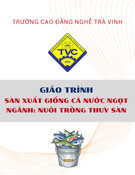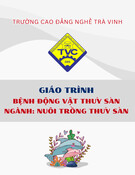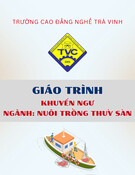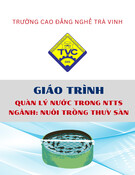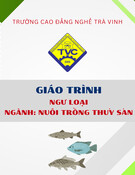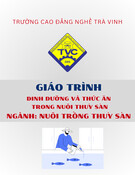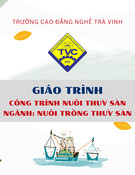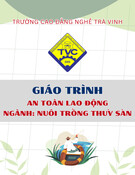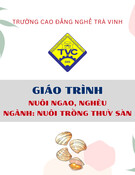
75
https://doi.org/10.52111/qnjs.2023.17108
Tạp chí Khoa học Trường Đại học Quy Nhơn, 2023, 17(1), 75-85
Thành phần loài cá rạn san hô vùng biển
ven bờ Bắc Hải Vân - Sơn Chà, tỉnh Thừa Thiên Huế
Lê Nguyễn Thới Trung1, Võ Điều2,*, Nguyễn Ngọc Hòa1
1Bảo tàng thiên nhiên Duyên hải miền Trung, Việt Nam
2Khoa Thủy sản, Trường Đại học Nông Lâm, Đại học Huế
Ngày nhận bài:10/10/2022; Ngày nhận đăng: 15/11/2022; Ngày xuất bản: 28/02/2023
TÓM TẮT
Nghiên cứu thành phần cá rạn san hô vùng biển ven bờ Bắc Hải Vân - Sơn Chà, tỉnh Thừa Thiên Huế được
thực hiện từ tháng 01 năm 2020 đến tháng 10 năm 2022 nhằm mục đích cập nhật dữ liệu, góp phần xây dựng luận
chứng khoa học - kỹ thuật cho việc thiết lập khu bảo tồn biển. Vị trí thu mẫu gồm 4 điểm là Bãi Cả, Bãi Chuối,
Sũng Rau Câu và đảo Sơn Chà. Mẫu được thu bằng lưới, lừ, vợt và súng bắn tên/xiên theo định kỳ 2 tháng/lần.
Kết quả nghiên cứu đã xác định được 142 loài thuộc 94 chi, 48 họ, 23 bộ cá rạn san hô. Trong đó, 5 bộ có số
lượng loài cao gồm Perciformes (36 loài), Ovalentaria (20 loài), Kurtiformes (14 loài), Labriformes (13 loài) và
Tetraodontiformes (8 loài). Các bộ còn lại chỉ có từ 1 đến 5 loài. Kết quả nghiên cứu cũng cho thấy độ phong phú
về thành phần loài cá ở các điểm khảo sát có sự khác nhau. Trong đó, đảo Sơn Chà có độ phong phú về loài cao
nhất với 71 loài thuộc 48 chi, 28 họ và 16 bộ; thấp nhất là Bãi Cả với 51 loài thuộc 35 chi, 24 họ và 13 bộ.
Từ khóa: Cá rạn san hô, Hải Vân - Sơn Chà, đa dạng thành phần loài cá.
*Tác giả liên hệ chính.
Email: vodieu@huaf.edu.vn hoặc vodieu@hueuni.edu.vn
TRƯỜNG ĐẠI HỌC QUY NHƠN
KHOA HỌC
TẠP CHÍ

76
QUY NHON UNIVERSITY
SCIENCE
JOURNAL OF
Quy Nhon University Journal of Science, 2023, 17(1), 75-85
https://doi.org/10.52111/qnjs.2023.17108
Species composition of coral reef fish
in the coastal areas of North Hai Van - Son Cha,
Thua Thien Hue province
Le Nguyen Thoi Trung1, Vo Dieu2,*, Nguyen Ngoc Hoa1
1Central Coast Nature Museum, Vietnam
2Faculty of Fisheries, University of Agriculture and Forestry, Hue University, Vietnam
Received:10/10/2022; Accepted: 15/11/2022; Published: 28/02/2023
ABSTRACT
The study on coral reef fish species composition in the coastal areas of North Hai Van - Son Cha, Thua
Thien Hue province was carried out in the period from January, 2020 to October, 2022 at 4 sites, namely Bai Ca,
Bai Chuoi, Sung Rau Cau, Son Cha island to update scientific data to contribute to establishing the marine reserve.
Fish were collected using fish nets, fish traps, scoops and spears every two months. 142 coral reef fish species
belonging to 94 genus, 48 families and 23 orders were found. There were 5 orders with large number of species
such as Perciformes (36 species), Ovalentaria (20 species), Kurtiformes (14 species), Labriformes (13 species)
and Tetraodontiformes (8 species). Other orders had from 1 to 5 species. Fish species composition abundance
was different between the study sites, of which the highest diversity was found at Son Cha island, with 71 species
belonging to 48 genus, 28 families and 16 orders while the poorest composition was recorded at Bai Ca, with 51
species belonging to 35 genus, 24 families and 13 orders.
Keywords: Coral reef fish, Hai Van - Son Cha, fish species composition diversity.
*Corresponding author.
Email: vodieu@huaf.edu.vn or vodieu@hueuni.edu.vn
1. INTRODUCTION
Thua Thien Hue is one of the central provinces
with a long coastline and high marine
biodiversity, of which North Hai Van - Son
Cha is a typical area. According to Nguyen Van
Tien and Nguyen Huy Yet,1 Hai Van - Son Cha
(from Lap An lagoon to South Hai Van) has high
biodiversity with 245 microalgae species, 74
zooplankton species, and 135 seaweed species, 3
seagrass species, 14 mangrove species, 142 coral
species, 303 benthic animal species, 162 coral
reef fish species and 4 sea turtle species. Coral
reefs are typical ecosystems of this area and are
mostly located at Bai Ca, Bai Chuoi, Bai Dau
Heo, Sung Rau Cau, West Son Cha, Northwest
Son Cha and South Hai Van.
Based on the high biodiversity, Hai Van -
Son Cha was proposed to establish a marine
protected area in 1998 (Nguyen Chu Hoi et
al.).2 In this proposal, Hai Van - Son Cha marine
reserve composes three areas in the south of
Phu Loc district, Thua Thien Hue province,
namely Son Cha island, Lang Co lagoon and
North Hai Van. The total area of the proposed
reserve is about 6,000 - 7,000 ha. Then, Nguyen
Van Tien and Nguyen Huy Yet1 investigated

77
QUY NHON UNIVERSITY
SCIENCE
JOURNAL OF
https://doi.org/10.52111/qnjs.2023.17108
Quy Nhon University Journal of Science, 2023, 17(1), 75-85
to collect scientific evidence and submitted
the People's Committee of Thua Thien Hue
province the proposal to establish Hai Van -
Son Cha as marine reverse with a total area of
9,503 ha (from Lap An lagoon to South Hai
Van). Throughout additional surveys, Hai Van -
Son Cha was officially involved in the list of 16
marine reserves approved by the Prime Minister
in 2010 (Decision No. 742/QĐ-TTg).3 The total
area of this reserve is 17,039 ha, of which the
marine area is 7,626 ha. Up to now, most of the
marine protected areas in the central region in
the list approved by the Prime Minister have
been established such as Con Co, Cu Lao Cham,
Ly Son, Nha Trang Bay, Nui Chua, Hon Cau but
not for Hai Van - Son Cha.
The coastal areas of North Hai Van - Son
Cha is an important fishing ground for 38.5% of
households living in Lang Co and the surrounding
areas (Le Thi Nguyen and Nguyen Bac Giang).4
In addition, this area is also the fishing ground of
many fishermen in Lien Chieu district, Da Nang
city (Nguyen Van Tien and Nguyen Huy Yet).1
Therefore, the pressure from exploitation on
biodiversity and ecosystems in general and on
coral reef fish resource of this sea in particular is
very large. However, because Hai Van – Son Cha
has not been established as a conservation area,
biodiversity in this area in general and coral reef
fish in particular has not been properly managed
and exploited.
This study aimed to update data and
contribute to building scientific evidences to
establish the Hai Van – Son Cha marine reserve
in Thua Thien Hue province.
2. METHODS
2.1. Study sites and period
Study period: This study was conducted in the
period of 01/2020 - 10/2022.
Study sites: Fish were collected at 4 sites
in the coastal areas of North Hai Van, Thua Thien
Hue province (Table 1 and Figure 1).
Table 1. Sample collection sites.
No. Sites Longitude Latitude
1Bai Ca 108,12152o16,21450o
2Bai Chuoi 108,14370o16,21628o
3Sung Rau
Cau 108,18161o16,21332o
4Son Cha
island 108,20192o16,22358o
Figure 1. Sample collection sites.
2.2. Sample collection
Fish were collected at the study sites every 2
months (total of 16 times of sampling) using
fishing gears such as gillnets, scoops, spears. A
total of 726 fish individuals were collected.
After collection, fish were washed and
kept into the frozen containers and transferred
to the preliminary sample analysis site in the
field. Here, fish were preliminarily classified
according to their morphology. Then 6-8
individuals were selected to take pictures and
tag the sample code. Then, these fish were fixed
in 10% formalin solution and transferred to the
Central Coast Nature Museum, KQH7 (Diem
Phung Thi Street, Vy Da ward, Hue city, Thua
Thien Hue Province) for analysis.
2.3. Sample analysis
Fish were classified using morphological
methods. The fish classification documents of

78
QUY NHON UNIVERSITY
SCIENCE
JOURNAL OF
Quy Nhon University Journal of Science, 2023, 17(1), 75-85
https://doi.org/10.52111/qnjs.2023.17108
authors as Nguyen Huu Phung et al.,5-8 Mansor
et al.,9 Rainboth et al.10 and Nelson11 were used.
In addition, the website http://www.
fishbase.org was also used to update fish
classification information. The fish taxon was
based on the method of Nelson.11
3. RESULTS AND DISCUSSION
3.1. Fish species composition diversity
In the study period, 142 coral reef fish species
belonging to 94 genus, 48 families and 23
orders were found in North Hai Van – Son Cha
(Table 2).
Table 2. The list of coral reef fish species in the coastal areas of Hai Van – Son Cha.
Number Order/ Subseries Number Species
I Anguilliformes 1Pisodonophis boro (Hamilton, 1822)
2Gymnothorax undulatus (Lacepède, 1803)
II Clupeiformes 3Encrasicholina punctifer (Fowler, 1938)
4Stolephorus sp.
5Stolephorus commersonnii (Lacepède, 1803)
6Sardinella gibbosa (Bleeker, 1849)
III Siluriformes 7Plotosus sp.
8Plotosus lineatus (Thunberg, 1787)
IV Aulopiformes 9Synodus dermatogenys (Fowler, 1912)
10 Trachinocephalus myops (Forster, 1801)
V Holocentriformes 11 Myripristis pralinia (Cuvier, 1829)
12 Sargocentron praslin (Lacepède, 1802)
13 Sargocentron rubrum (Forsskål, 1775)
14 Sargocentron melanospilos (Bleeker, 1858)
VI Kurtiformes 15 Apogon imberbis (Linnaeus, 1758)
16 Apogonichthyoides taeniatus (Cuvier, 1828)
17 Cheilodipterus macrodon (Lacepède, 1802)
18 Jaydia melanopus (Weber, 1911)
19 Lepidamia kalosoma (Bleeker, 1852)
20 Ostorhinchus aureus (Lacepède, 1802)
21 Ostorhinchus cookii (Macleay, 1881)
22 Ostorhinchus doederleini (Jordan & Snyder, 1901)
23 Ostorhinchus endekataenia (Bleeker, 1852)
24 Ostorhinchus lateralis (Valenciennes, 1832)
25 Ostorhinchus semilineatus (Temminck & Schlegel, 1842)
26 Ostorhinchus compressus (Smith & Radcliffe, 1911)
27 Ostorhinchus fasciatus (White, 1790)
28 Taeniamia fucata (Cantor, 1849)

79
QUY NHON UNIVERSITY
SCIENCE
JOURNAL OF
Quy Nhon University Journal of Science, 2023, 17(1), 75-85
https://doi.org/10.52111/qnjs.2023.17108
VII Gobiiformes 29 Butis butis (Hamilton, 1822)
30 Oxyurichthys sp.
31 Glossogobius giuris (Hamilton, 1822)
VIII Ovalentaria 32 Ambassis kopsii (Bleeker, 1858)
33 Chromis margaritifer (Fowler, 1946)
34 Chromis xanthura (Bleeker, 1854)
35 Dascyllus trimaculatus (Rüppell, 1829)
36 Neoglyphidodon melas (Cuvier, 1830)
37 Neoglyphidodon nigroris (Cuvier, 1830)
38 Neopomacentrus azysron (Bleeker, 1877)
39 Neopomacentrus cyanomos (Bleeker, 1856)
40 Plectroglyphidodon leucozonus (Bleeker, 1859)
41 Pomacentrus brachialis (Cuvier, 1830)
42 Pomacentrus coelestis (Jordan & Starks, 1901)
43 Pomacentrus flavioculus (Allen, Erdmann & Pertiwi, 2017)
44 Pomacentrus moluccensis (Bleeker, 1853)
45 Pomacentrus simsiang (Bleeker, 1856)
46 Stegastes obreptus (Whitley, 1948)
47 Stegastes sp.
48 Abudefduf saxatilis (Linnaeus, 1758)
49 Abudefduf sexfasciatus (Lacepède, 1801)
50 Abudefduf sordidus (Forsskål, 1775)
51 Amphiprion clarkii (Bennett, 1830)
IX Mugiliformes 52 Osteomugil cunnesius (Valenciennes, 1836)
53 Upeneus sulphureus (Cuvier, 1829)
X Blenniiformes 54 Aspidontus sp.
55 Aspidontus taeniatus (Quoy & Gaimard, 1834)
56 Cirripectes filamentosus (Alleyne & Macleay, 1877)
57 Istiblennius edentulus (Forster & Schneider, 1801)
58 Meiacanthus sp.
XI Atheriniformes 59 Atherinomorus lacunosus (Forster, 1801)
XII Beloniformes 60 Hemiramphus lutkei (Valenciennes, 1847)
61 Hyporhamphus quoyi (Valenciennes, 1847)
XIII Carangiformes 62 Alepes apercna (Grant, 1987)
63 Alepes djedaba (Forsskål, 1775)
64 Selaroides leptolepis (Cuvier, 1833)
65 Trachinotus mookalee (Cuvier, 1832)


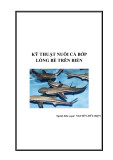
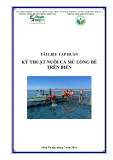

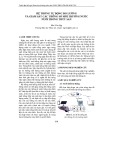

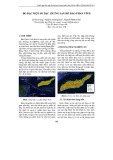
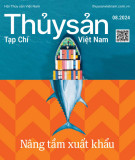
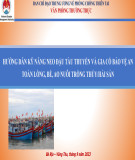
![Đề ôn tập môn Thủy sản đại cương [năm học mới nhất]](https://cdn.tailieu.vn/images/document/thumbnail/2025/20250402/laphongtrang0906/135x160/7712268.jpg)
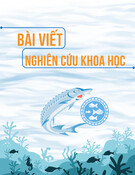
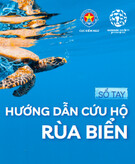
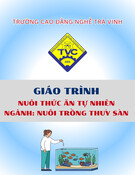
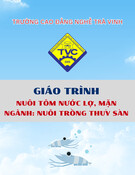
![Giáo trình Sản xuất giống tôm nước lợ, mặn (Trung cấp/Cao đẳng) - Trường Cao đẳng nghề Trà Vinh [Mới nhất]](https://cdn.tailieu.vn/images/document/thumbnail/2025/20251115/kimphuong1001/135x160/76031763179346.jpg)

